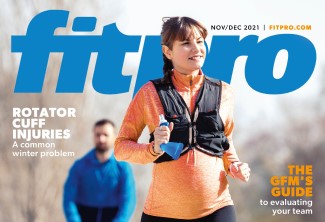Magazine References
Nov – Dec 2021

Pg 6-7 Losing it: A new approach to weight loss
References
- Donnelly J et al (2009), Appropriate physical activity intervention strategies for weight loss and prevention of weight regain for adults, MSSE, 41(2): 459-471.
- Feigal K et al (2013), Association of all-cause mortality with overweight and obesity using standard body mass index categories: a systematic review and meta-analysis, JAMA, 309: 71-82.
- Elagizi A et al (2018), An overview and update on obesity and the obesity paradox in cardiovascular diseases, Progress in Cardiovascular Disease, 61(2): 142-150.
- Meyers J et al (2017), Cardiorespiratory fitness and reclassification of risk for incidence of heart failure: The veterans exercise testing study, Cir Heart Fail, 10(6): e003780.
- Lee et al (2011), Long term effects of changes in cardiorespiratory fitness and body mass index on all; cause and cardiovascular disease mortality in men: The aerobics centre longitudinal study, Circulation, 124(23): 2,483-90.
- Glumer C et al (2003), Prevalence of diabetes and impaired glucose regulation in the Danish population, Diabetes Care, 26(8): 2,335-40.
- Glenn G, Angardi S (2021), Obesity treatment: Weight loss versus increasing fitness and physical activity for reducing health risks, I, Science, doi: org/10.1016/j.isci.102995, accessed on 30 September 2021.
The quest for a healthy spine and shoulders
References
- Rusin J, Shoulder/Pulling Health, https://drjohnrusin.com, accessed on 14 September 2021.
- McGill S, Low Back Performance – https://pubmed.ncbi.nim.nih.gov, accessed on 14 September 2021.
- TRX Suspension Training instructor education – 5 TRX exercises to build a stronger back, https://sg.eastcoasttrainingzone.com, accessed on 14 September 2021.
- ViPR Global LMT 1 online/live course (whole-body strength using myofascial lines).
- Siff M and Verhoshansky Y, http://educ.jmu.edu (Conjugate Strength Training – James Madison University), accessed on 14 September 2021.
- Gray Institute, Matrices (Functional video digest series), V45 ‘Matrix system functioning’.
Pg 12-13
References
- Fish and shellfish – NHS (www.nhs.uk), accessed on 14 September 2021.
- Omega-3 Food Fact Sheet, British Dietetic Association (bda.uk.com), accessed on 14 September 2021.
- Yaghubi et al (2005), Dietary alpha-linolenic acid intake and risk of sudden cardiac death and coronary heart disease, Circulation, 112: 3,232-8.
- Raji C et al (2014), Regular fish consumption and age-related brain gray matter loss, Am J Prev Med., 47(4): 444-51.
- Mozaffarian D et al (2006), Fish intake, contaminants and human health: Evaluating the risk and the benefits, JAMA, 1,885-99.
- Joint FAO/WHO expert consultation on the risks and benefits of fish consumption (2010), Report of the Joint FAO/WHO Expert Consultation on the Risks and Benefits of Fish Consumption. rome, 25029 january 2010, accessed on 14 September 2021.
- Farmed fish. A healthy sustainable choice? https://www.eufic.org/en/food-production/article/farmed-fish-a-healthy-and-sustainable-choice, accessed on 14 September 2021.
- Jensen I et al (2020), An update on the content of fatty acids, dioxins, PCB’s and Heavy Metals in farmed, escaped and Wild Atlantic Salmon in Norway, Food, 9(12): 1,901.
- Sustainable seafood, Sustainability and responsible sourcing – Love Seafood, accessed on 14 September 2021.
- Environmental Defence Fund, https://seafood.edf.org/guide/worst, accessed on 14 September 2021
- Yaghubi E et al (2021), Farmed mussels: A nutritive protein source, rich in omega-3 fatty acids with a low environmental footprint, Nutrients, 13: 1,124.
Pg 24-27 Helping clients recover from rotator cuff injuries
References
- Yamamoto A et al (2010), Prevalence and risk factors of a rotator cuff tear in the general population, Journal of Shoulder and Elbow Surgery, 116-120.
- Kocher M & Feagin A (1996), Shoulder injuries during alpine skiing, American Journal of Sports Medicine, 24(5): 665-9.
- American Council on Exercise (2010), ACE Personal Trainer Manual (4th Edition), American Council on Exercise.
- Gray H (1995), Gray’s Anatomy, New York: Barnes & Noble Books.
- Cook, Gray (2010), Movement, Aptos, CA: On Target Publications.
- Price J & Bratcher M (2019), The BioMechanics Method Corrective Exercise Specialist Certification Program (2nd Edition), The BioMechanics Press.
- Price J (2018), The BioMechanics Method for Corrective Exercise, Champaign, IL: Human Kinetics.
- Kendall F, McCreary E & Provance P (1993), Muscles; Testing and Function (4th Edition), Philadelphia: Lippincott Williams and Wilkens.
- Myers T (2001), Anatomy Trains. Myofascial Meridians for Manual and Movement Therapists, Edinburgh: Churchill Livingstone.
- Rolf IP (1989), Rolfing: Reestablishing the Natural Alignment and Structural Integration of the Human Body for Vitality and Well-Being (revised edition), Rochester, VT: Healing Arts Press.
Pg 32-35 Plyometric training: Case studies
References
- Orchard JW, Blanch P, Paoloni J, Kountouris A, Sims K, Orchard JJ, Brukner P (2015), Fast bowling match workloads over 5–26 days and risk of injury in the following month, Journal of Science and Medicine in Sport, 18(1): 26-30.
- Finch CF, White P, Dennis R, Twomey D, Hayen A (2010), Fielders and batters are injured too: a prospective cohort study of injuries in junior club cricket, Journal of Science and Medicine in Sport, 13(5): 489-95.
- Stretch RA, Venter DJ (2005), Cricket injuries-a longitudinal study of the nature of injuries to South African cricketers, South African Journal of Sports Medicine, 17(3): 4-10.
- Worthington P, King M, Ranson C (2013), The influence of cricket fast bowlers’ front leg technique on peak ground reaction forces, Journal of Sports Sciences, 31(4): 434-41.
- Stronach BJ, Cronin JB, Portus MR (2014), Part 2: mechanical and anthropometric factors of fast bowling for cricket, and implications for strength and conditioning, Strength & Conditioning Journal, 36(5): 53-60.
- Soomro N, Hackett D, Freeston J, Blanch P, Kountouris A, Dipnall J, Lyle D, Sanders R (2018), How do Australian coaches train fast bowlers? A survey on physical conditioning and workload management practices for training fast bowlers, International Journal of Sports Science & Coaching, 13(5): 761-70.
- Glazier P, Paradisis GP, Cooper SM (2000), Anthropometric and kinematic influences on release speed in men’s fast-medium bowling, Journal of Sports Sciences, 18(12): 1,013-21.
- Loram LC, McKinon W, Wormgoor S, Rogers GG, Nowak I, Harden LM (2005), Determinants of ball release speed in schoolboy fast-medium bowlers in cricket, Journal of Sports Medicine and Physical Fitness, 45(4): 483.
- Portus MR, Mason BR, Elliott BC, Pfitzner MC, Done RP (2004), Cricket: Technique factors related to ball release speed and trunk injuries in high performance cricket fast bowlers, Sports Biomechanics, 3(2): 263-84.
- Pyne DB, Duthie GM, Saunders PU, Petersen CA, Portus MR (2006), Anthropometric and strength correlates of fast bowling speed in junior and senior cricketers, The Journal of Strength & Conditioning Research, 20(3): 620-6.
- Prassas S, Kwon YH, Sands WA (2006), Biomechanical research in artistic gymnastics: a review, Sports Biomechanics, 5(2): 261-91.
- Moeskops S, Oliver JL, Read PJ, Cronin JB, Myer GD, Lloyd RS (2019), The physiological demands of youth artistic gymnastics: applications to strength and conditioning, Strength & Conditioning Journal, 41(1): 1-3. Sands WA (2000), Injury prevention in women’s gymnastics, Sports medicine, 30(5): 359-373.
- Burgess R, Noffal G (2001), Kinematic analysis of the back salto take-off in a tumbling series: advanced vs. beginner techniques. In ISBS-Conference Proceedings Archive 2001 McNeal JR, Sands WA, Shultz BB (2007), Muscle activation characteristics of tumbling take-offs, Sports Biomechanics, 6(3): 375-90.
- Marshall SW, Covassin T, Dick R, Nassar LG, Agel J (2007), Descriptive epidemiology of collegiate women’s gymnastics injuries: National Collegiate Athletic Association Injury Surveillance System, 1988–1989 through 2003–2004, Journal of Athletic Training, 42(2): 234.
- Chase MA, Magyar TM, Drake BM (2005), Fear of injury in gymnastics: Self-efficacy and psychological strategies to keep on tumbling, Journal of Sports Sciences, 23(5): 465-75.
- McNeal JR, Sands WA, Shultz BB (2007), Muscle activation characteristics of tumbling take-offs, Sports Biomechanics, 6(3): 375-90.
- Sands WA (2000), Injury prevention in women’s gymnastics, Sports Medicine, 30(5): 359-73.


